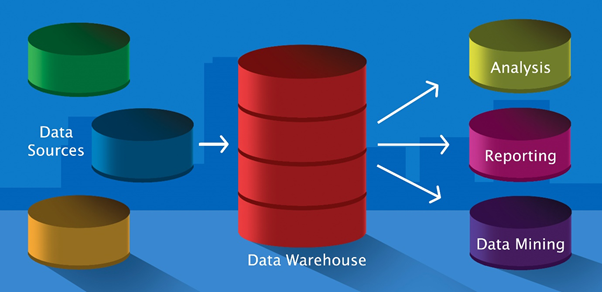What is data warehousing?
Data warehousing is defined as the method of gathering & handling data from different sources to get meaningful output and insights. Data warehousing is central to the BI system and is built for data analysis and reporting.

Source: © nfo40555 | Megapixl.com
In simple terms, a data warehouse is a large collection of data utilized by businesses to make investment decisions.
What are the characteristics of data warehousing?
Data warehouse has supported businesses in making informed decisions efficiently. Some of its key features are highlighted below:
- The data in a data warehouse is structured for easy access, and there is high-speed query performance.
- The end users generally look for high speed and faster response time – two features present in data warehousing.
- Large amount of historical data is used.
- Data warehouse provides a large amount of data for a particular query.
- The data load comprises various sources & transformations.
What are the benefits of data warehousing?
The Companies which used data warehousing for analytics and business intelligence found several advantages. Below are some of them:
Better Data: When data sources are linked to a data warehouse, the Company can collect consistent and relevant data from the source. Also, the user would not have to worry about the consistency and accessibility of the data. Thus, it ensures data quality and integrity for sound decision making.
Faster decisions: Through data warehousing, it is possible to make quicker decisions as the data available is in a consistent format. It offers analytical power and a comprehensive dataset to base decisions on tough truths. Thus, the people involved in decision making do not have to rely on hunches, incomplete data, and poor quality data. It also reduces the risk of delivering slow and inaccurate data.
How does a data warehouse work?
A data warehouse is like a central repository where the data comes from various sources. The data streams into the data warehouse from the transactional system and other relational databases. These data could either be structured, semi-structured or unstructured.
These data get processed, altered, and consumed in a way that the end-user can gain access to the processed data in the data warehouse via business intelligence (BI) devices, SQL clients and spreadsheets. A data warehouse merges the data that comes from various sources into a complete database.
The biggest advantage of this merged data is that the Company can analyze the data more holistically. It also makes the process of data mining smooth.

Copyright © 2021 Kalkine Media Pty Ltd.
Component of a data warehouse
A data warehouse can be divided into four components. These are:
Load Manager
Load Manager, also known as the front component, does operations related to the mining and loading the data into a data warehouse. Load manager transforms the data for entering into Data warehouse.
Warehouse Manager
The warehouse manager manages the data within the data warehouse. It analyses data to confirm that the data in the data warehouse is steady. It also conducts operations such as the creation of indexes and views, generation of denormalization and aggregations, modifying and integrating the source data.
Query Manager
Query Manager is a backend component that does operations concerning the supervision of user queries.
End-User access tools
End-User access tools comprise data reporting, query tools, application development tools, EIS tools, data mining tools, and OLAP tools.
Roles of Data Warehouse Tools and Utilities
The tools and utilities in a data warehouse are used for:
- Data extraction: The data extraction process involves gathering data from heterogeneous sources.
- Data cleaning: Data cleaning consists of searching for any error in the data.
- Data transformation: Data transformation process involves changing the data into a data warehouse setup.
- Data loading: This process involves data sorting, recapping, consolidating, verifying integrity.
- Refreshing: This process requires revising data sources to the warehouse.
Application of data warehouse
Data warehouse plays a considerable role across multiple sectors. Some of the sectors it caters to are highlighted below.
Aviation sector
In the aviation sector, a data warehouse’s role can be seen in crew assignment, route profitability analysis, any promotional activity.
Banking Industry
In the banking sector, the focus is on risk management, policy reversal, customer data analysis, market trends, government rules and regulations and making financial decision.
Through a data warehouse, banks can manage the resources available on the deck effectively. Banks also take the help of a data warehouse to do market research, analyze the products they offer, develop marketing programs.
Retail industry
Retailers act as an intermediary between the producers and the customers. Hence, these retailers use a data warehouse to maintain the records of both producers as well as the customer to maintain their existence in the market.
Data warehouses help track inventory, advertisement promotions, tracking customer buying trends and many more.
Healthcare industry
In the healthcare industry, a data warehouse is used to predict the outcome of any test and taking relevant action accordingly. Data warehouses help them to generate patient treatment report, offer medical services, track the medicine inventory. Many patients visiting hospital have health insurance. Through a data warehouse, hospitals maintain the list of insurance providers.
Investment and insurance sector
In the insurance and investment sector, the role of data warehouse becomes important in tracking the data pattern, customer trend and market movement.
Services sector
In the services sector, a data warehouse is used for maintaining financial records, studying the revenue pattern, customer profiling, resource management and human resource management.
Telecom
The telecom sector uses a data warehouse in the promotion of its offerings, making sales decision, distribution decision, features to include in case they decide to launch a new product based on the customer requirement.
Hospitality
The hospitality sector involves hotel and restaurant services, car rental services etc. In this sector, the companies use a data warehouse to study the customer feedback on the various services offered and accordingly design and evaluate their advertising and promotion campaigns.
 Please wait processing your request...
Please wait processing your request...